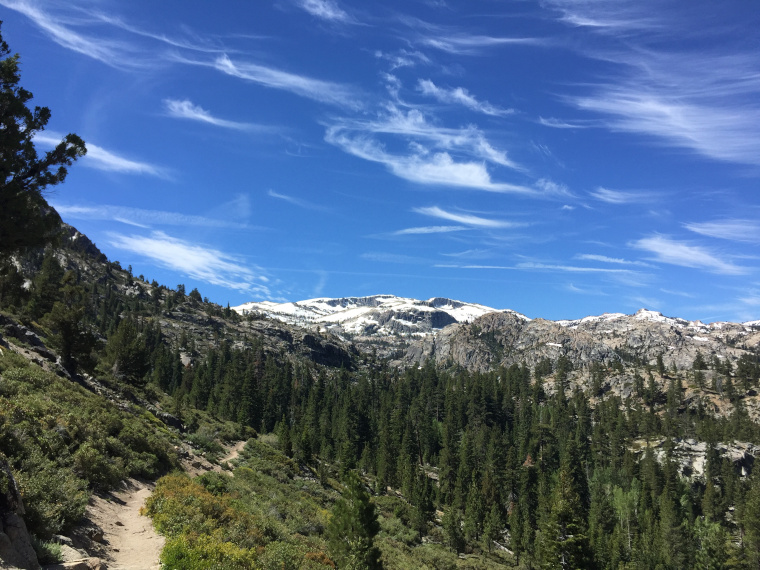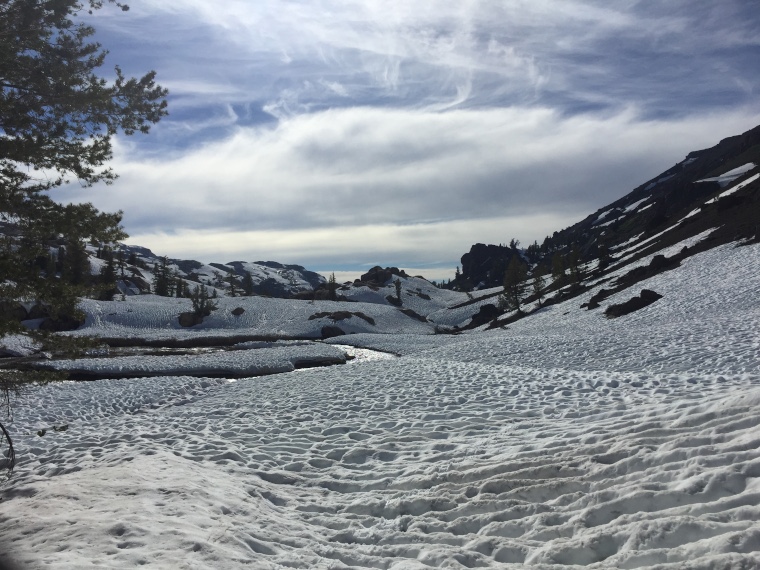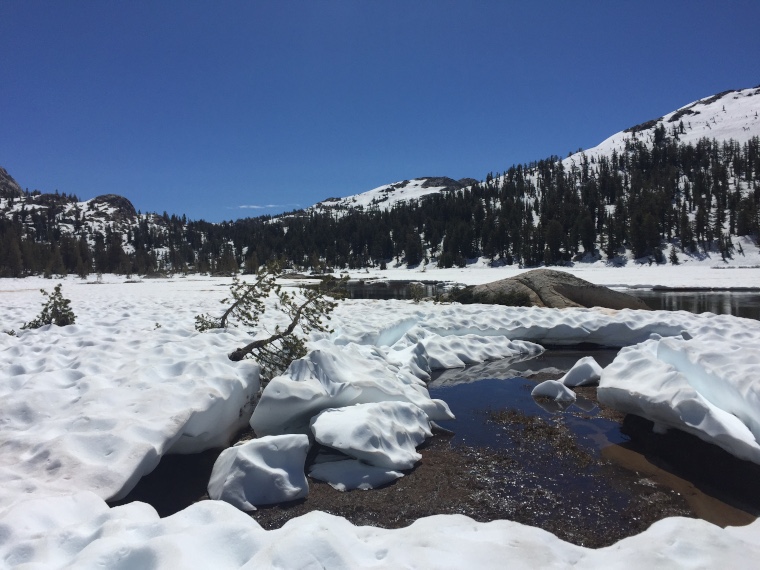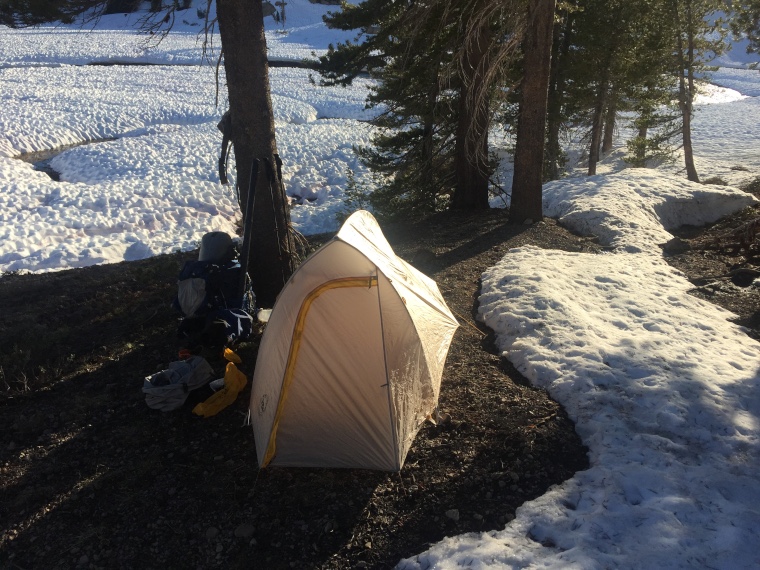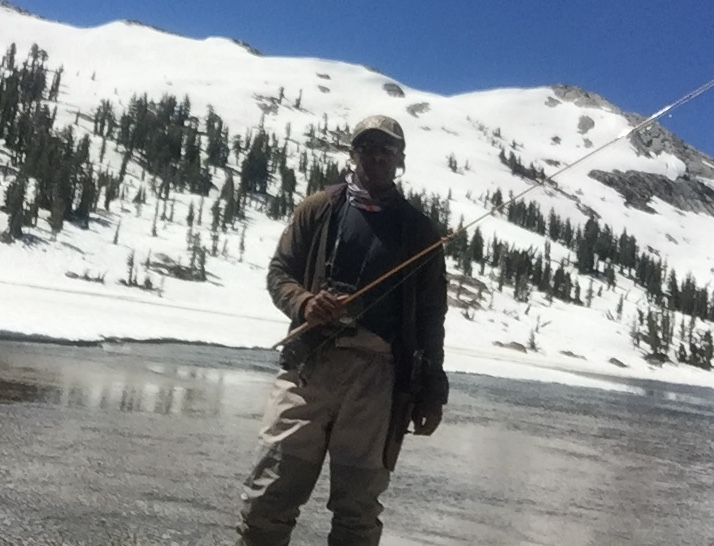I lay in my car the night
before my long backpacking trip wondering if I
should follow through with my plans.
The plan- hike to Twin
Lakes in Yosemite via Snow Lake and Emigrant
Meadow over Brown Bear pass. I had planned to
hike into Twin during my long trip last year but
as my first long backpacking trip since my back
issues, I didn’t have the confidence or fitness
to follow through. That bugged me. It bugged me
a lot. It bugged me for an entire year.
This year, early season
snow conditions looked to scuttle my plans. As
the trip approached, numerous reports surfaced
of unprecedented snow levels in the Emigrant.
The reports contradicted themselves. The week
prior, I’d seen pictures of what I’d recognized
as Lunch Meadow completely covered by snow. The
day of, I’d had been given reports from people
saying they’d worked their way up to Sheep Camp
and Lunch Meadow; and that, snow was only an
issue beyond Lunch Meadow. This had me excited
and optimistic but would ultimately turn out to
not be the case. The route up to Sheep Camp was
treacherous and beyond that, everything was
covered by several feet of snow.
I’d come prepared. In
addition to my normal backpacking gear, I
carried snowshoes, heavier clothing, heavier
gloves and an extra pair of socks. I also went
out and purchased a new pair of water proof
Altra Lone Peak RSMs and gaiters, instead of
choosing to carry my NEOS overshoes with as I’ve
done in the past. In all, I was carrying 8 to
10lbs of additional gear.
I’d also developed a
possible “Plan B” for my trip. If things were
too bad, I’d head to Emigrant Lake over Mosquito
pass, which is lower in elevation than Brown
Bear pass. If hiking to Twin appeared to be too
tough from Emigrant, I’d head to Buck Lakes. I
informed the Ranger station of my plans and they
made note on my permit. Those were decisions for
later.
First up was to make the
trek. This was my first high country foray of
the year. During most years I’ve had hikes in
May and June to prepare me for the long
backpacking trip but snow conditions and family
obligations were such that I’d have very little
high country conditioning going into this trip.
It was tough, the lack of conditioning, the
extra weight on my back and the trail conditions
on the way to Summit Creek meant I was knackered
well before reaching the bluff to Sheep Camp.
Trail conditions weren’t
terrible but the high water crossing at Relief
Reservoir and the occasional snow bank and
fallen timber just made it a tad more work than
usual. I arrived at Summit Creek pretty beat but
with the knowledge that I’d done the hike many
times before and could push through and get it
done.
At Summit Creek, I ran into
a group of hikers that said hiking up to Sheep
Camp would “be a challenge”. This was the first
indication that the beta I received earlier
was…… “off”. Hiking became more challenging.
Soft snow appeared more often, forcing me to don
my gaiters. When I got to the bluff below Sheep
Camp it looked daunting, the majority of the
trail was obscured by snow but I knew that at
least one individual had made the hike and
returned the week earlier and the mantra “What
one man can do, another can do” entered my
thoughts.
I scanned the route and saw
a man and a women snow shoeing up the bluff. I
presumed they were on the trail so I made a
beeline in their general direction. I scaled the
granite and quickly caught them at the point at
which the granite almost completely gave way to
steep snow banks. We were nearly to the top but
came to a steep snow chute with granite on
either side of it. It was a short distance,
maybe 15 feet but a slip would have sent us into
the side of a large granite boulder and then 40
or so feet into the trees and rocks below. The 3
of us stood looking at, pondering the route up.
My snow shoed companions
contemplated their options. Reassured by their
presence and the knowledge that if anything went
south, someone would be able to get help
immediately, I firmly planted my feet in the
steep, icy snow and moved across the gap.
Successfully. It was sketchy. Sketchy enough
that my momentary companions decided on a
another route. I hoped that I wouldn’t need to
do it again on the way back (I would). Once
across, I was faced with the prospect of making
one last snow bound push up to Sheep Camp.
I put on my snowshoes and
steadily angled my way up toward the opening in
the rocks that acts as the pass to Sheep Camp.
When I turned around, my snow shoed companions
were still trying to determine what they were
going to do. I saw them descend to the very
bottom of the snow chute I had just traversed
and gave them a shot to let them know that I had
made it safely.
It was slower going past
Sheep Camp. Snow mostly but I took the snowshoes
off until I reached lower Lunch Meadow. Lunch
Meadow was icy snow cups and the trail was
completely obscured. Not too much of an issue
here, you simply head to the other side and
avoid any covered water. Generally, moving water
was easy to identify by the smooth, rather than
cupped surface of the snow. By then, I’d found
my second wind, no doubt due to the adrenaline
rush of ascending Sheep Camp. It was late in the
afternoon but the plan was clear, push on to
Emigrant Lake and try to arrive by night fall.
I found a snow bridge over
the creek and snowshoed my way up and over
Mosquito Pass. It was slow going. A hike that
usually takes 2 hours took 6.
I arrived
within a half mile of Emigrant Lake at 11pm. The
creek was too high to safely cross in the dark
so I decided to pitch my tent and look for a
good crossing spot in the morning.
I hadn’t made any special
plans for snow camping but had instead planned
on using my emergency “blanket” as an extra
ground cloth layer. More of a test than anything
else. I was confident that between my down
sleeping bag and extra cloths, I had more than
enough to keep me warm if needed. I was curious
if my SOL Escape Lite Bivy would work as extra
insulation between me and my 3 season Thermarest
Neoair sleeping and it did. The cold of the snow
radiated up from through the thin material that
makes up the floor of my Big Agnes UL tent, yet
I slept very comfortably. I did have a temporary
set back as I unpacked my tent (only in the
second season of use) and found the elastic used
to keep the tent poles together had failed.
Fortunately, a little duct tape and I was back
in business and quickly asleep.
The next morning I easily
crossed the creek and made by way to Emigrant
Lake.
Emigrant was completely snowed in and most of the lake still frozen. I dropped by backpacking gear at my regular camping spot assembled my fishing gear. It was obviously to snowy to trek on to Twin Lakes. The fishing conditions would dictate whether I decided to stay at Emigrant for any length of time.
Snow still covered the
meadow and hidden lakes near the inlet to
Emigrant Lake. The inlet itself had ice along
it’s edges and beyond the inlet the lake was
still frozen. That said, much of the water that
I like to fish was open and fishable with
careful wading a navigation of the surrounding
bank.
Mosquitos were yet to
hatch, which made for a pleasant but very cold
visit.
Unfortunately, the fish weren’t active
nor on station. I fished the flats, worked up
the inlet a bit but saw few if any fish. Knowing
this area as well as I do, I decided to cut my
loses and head back to the trail head. I could
be out of the Emigrant in two days and that
would give me the rest of the week to fish
elsewhere.
It was 6 hour of snowshoeing back to Lunch Meadow. I arrived near dusk and decided to spend the night. The next morning I was somewhat dreading the decent down the bluff past Sheep Camp. It was steep and I knew I’d have to allow the snow to soften a bit to get proper purchase with my snowshoes. Sun cups made it slow going through Lunch Meadow but the uneven and sometimes steep terrain made for great practice as I approached Sheep Camp.
The bluff was intimidating
and of course looked steeper from the top than
when I had ascended it. I had contemplated
simply snowshoeing down the chute immediately
below the pass but I had my doubts so I decided
to trace my previous route and traverse to the
granite and then make the 15 or so feet across
the drop. 15 feet doesn’t seem like much but it
was at the limit of the steepness that my
snowshoes allowed me to walk down. Weight
forward, leaning into the fall, my snowshoes
held to the snow for all but the final few feet.
Once again on granite. I
removed my snowshoes and trekked back to the
trailhead to continue my trip in the Eastern
Sierra, outside of Lee Vining.
Video for this trip can be seen as the first 3 videos in this playlist: Long Sierra Trip 2019


